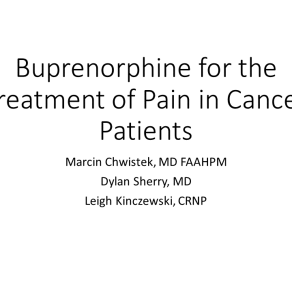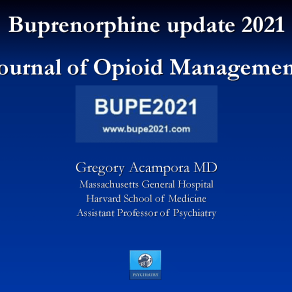The following questions and topics will be covered in this presentation.
1) Which of the following is true regarding buprenorphine’s clinical effects?
a)Buprenorphine causes lower risk of respiratory depression compared to full mu-opioid receptor agonists, thus is impossible to overdose on.
b) Buprenorphine has been shown to have lower analgesic efficacy compared to full mu-opioid receptor agonists.
c) Buprenorphine has shown to have reduced risk of respiratory depression, thus may be safer than full mu-opioid receptor agonists in patients with underlying respiratory disease.
d) Buprenorphine has not shown any clinical differences in terms of hypogonadal axis suppression compared to full mu-opioid receptor agonists.
2) Which of the following underlying mechanisms contributes to buprenorphine’s unique pharmacologic and clinical actions?
a) Buprenorphine has shown to recruit less beta-arrestin proteins to phosphorylated G-proteins coupled with mu-opioid receptors.
b) Buprenorphine has shown to recruit greater beta-arrestin proteins to phosphorylated G-proteins coupled with mu-opioid receptors.
c) Buprenorphine has a much lower binding affinity compared to full mu-opioid receptor agonists, thus effects can easily be overcome by using a full mu-opioid receptor agonist.
d) Buprenorphine effects all subtypes and subunits of G-proteins equally.
3) Which of the following typical opioid related side effect has buprenorphine clinically shown to have reduce risk/rates of?
a) Constipation
b) Respiratory depression
c) Euphoria
d) All of the above
4) True or False: Buprenorphine has shown to produce lower analgesic efficacy compared to full mu-opioid receptor agonists in clinical trials.
5) BL is a 48 yo male patient with chronic lower back pain secondary to multilevel DDD, facet arthropathy, and foraminal narrowing, as well as COPD, CHF, and essential HTN. His pain has been progressing in the lower back despite adequate trials of several non-pharmacologic and pharmacologic modalities, thus the interdisciplinary pain team is contemplating trial of an opioid analgesic. Which of the following best outlines buprenorphine’s role in this case?
a) Buprenorphine should be avoided, and a full mu-opioid receptor agonist should be used given patient’s pain is too severe to obtain benefit from buprenorphine.
b) Buprenorphine should be avoided because of patients significant history of cardiopulmonary ailments and is at significant risk for opioid-induced respiratory depression.
c) Buprenorphine should be considered over full mu-opioid receptor agonists considering patient’s history of cardiopulmonary ailments and reduced risk of respiratory depressive effects from buprenorphine.
d) Buprenorphine should be considered, though should not be considered over full mu-opioid receptor agonists due to cost and the fact that there is no difference in respiratory depression risk between them.











